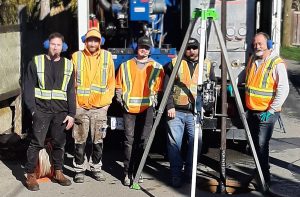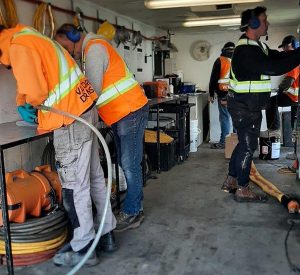
From left: Jamie Bryon, Orin Tufts, Ethan Okopski, Kevin Adams and Shawn Robinson
VICTORIA – Victoria Drains has a solution for broken, cracked, offset or open joints in underground pipes that is very environmentally friendly: Lining.
Their team uses state-of-the-art equipment to perform lining – which means installing a pipe within a pipe. That means no extra digging or soil disruption is required to stop leakages caused by damaged pipes.
“Lining is gaining in popularity because digging down to replace pipes is getting invasive,” notes Project Manager Shawn Robinson. “If someone has a plugged sanitary line – the line that goes from their house to a sanitary outlet – if it is having damage from the roots of a 100 year old tree, you can’t dig that up. We have the technology to remove the roots from the host pipe and install a liner in the host pipe.
“The liner has the same structural strength of the previous pipe, if not better. It is a continuous piece that minimizes any chance of the roots coming back in, and we can do everything from a 2-inch small diameter pipe up to 16 inches.”
Dave Lloyd started Victoria Drains out of necessity 18 years ago. After he had purchased a house, its basement was flooding and he couldn’t find anyone to dig out the perimeter drain and fix it, so he did it himself. Another neighbour had the same problem and he fixed that, too, and Victoria Drains was off and running.

Victoria Drains team members preparing a liner for installation
Today, the company has 30 full-time employees that do lining, as well as camera and CCTV (closed circuit television) inspections, excavation work, replace perimeter drains, sanitary lines, water lines – anything associated with excavation.
“We also do structural repairs and fix foundations when houses are sinking,” Robinson notes. “We work with various municipalities, like Victoria, Oak Bay, Saanich and others throughout Greater Victoria. We have serviced customers in Nanaimo, and we will go anywhere where necessary, on the North Island or the lower mainland.”
Where Victoria Drains’ lining comes in extra handy is in places like cemeteries, or older structures where there are protected root systems and trees.
“Digging in protected root zones around heritage trees is expensive, and municipalities are running into problems with contaminated soil, which can also drive up costs,” he says. “We can install a liner without digging anything up at all.”
Another example would be sanitary lines and storm lines on aged buildings.
“Often when it comes to the interiors, there could be cast iron pipes underneath the concrete slab in the basement, and this becomes an issue when people want to put suites in the basements of their house to maximize living space,” he explains.
“They might not know anything about the pipe under the house. When those pipe fail, we’ve seen sewage seeping up underneath, through the concrete.”
“Which means, if it’s a rental home, they would have to remove the tenants, jackhammer the cement out, take out the broken pipe, put in new pipe, then new flooring. That would mean months’ worth of work.”
Victoria Drains would use camera inspection and a liner within the existing pipe to re-line it, “and the people can live there while we work, or we can work around their schedule. We can re-line the pipe without displacement of the tenant or having to dig anything out.”
Victoria Drains can work with pipe as small as two inches in diameter, including vent stacks that become clogged and rotten, in kitchens or cabinets. They can clean them without removing the original pipe, and simply re-line it.
“Re-lining is something that truly works,” Robinson says. “It’s a very good product with a good life expectancy. These products do what we say they do and they last.”


